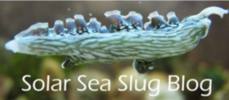

Ready to Extract
Decisions have been made, orders have been placed, and materials have arrived. It turns out that we are treading a relatively well-worn path of DNA bar-coding. The goal for the semester is to extract, amplify and sequence the rbcL gene for the candidate food plants and the chloroplasts maintained by the slugs. Because rbcL encodes a component of the photosynthetic complex of the chloroplast, and the gene is found in the genome of the chloroplast (rather than the nucleus of the plant), the origin of the chloroplasts that the slugs are carrying can be identified on the basis of the sequence of the gene. Fortunately for us, the sequence of the rbcL gene has been studied by a lot of people. The chloroplasts of all plants have it, but it varies a little from one species to another. That variation can be used to examine how closely related different species are, or to determine if two populations that resemble one another are actually different species. Each species has a unique sequence or “bar code,” that can be used to identify it, and to distinguish it from other species.
Therefore, much of the work has been done for us. Kits, such as the one in the above photo, are readily available, procedures are largely worked out for amplifying the amount of DNA using polymerase chain reaction (although the primers for these algae may be a little tricky), and there are companies such as GeneWiz that provide a relatively inexpensive and simple resource for sequencing the resulting DNA. Makes a nice change after a career spent soldering and tweaking in order to perform experiments using arcane methods.
On your next visit, you may find a photo of DNA bands on an agarose gel. Or maybe something else.

I was wondering how you will be sampling the slugs – kill and puree or small sample of parapodia tissue (canula, hole punch, or similar)?
If you keep the slugs alive, you and your students could monitor food preference over the life time of the slugs.
There’s something weird about the preference for bryopsis – bryopsis likes high flow etc, not what I would picture as prime Elysia habitat.
Hi Susan,
The DNA extraction only requires about 0.1 g of tissue, so I may be able to get away with clipping a parapodium rather than pureeing a whole animal.
I am not sure what to think about the preference for Bryopsis. There are apparently some Bryopsis species that prefer shallow, relatively calm water, but I certainly get the best growth in areas of high current. I am now getting sustainable (for the moment) production of two species of Bryopsis in the half-height ten gallon, under a 95 watt hydroponics light, with two small propeller pumps for circulation. The algae love the intense light and strong circulation.
As far as the slugs’ preference, it does seem that the three larger American species (clarki, crispata, diomedea) tend to avoid heavy turbulence. On the other hand, I am watching a slug right now that is clinging onto a patch of algae growing from tank inflow. Does not look like she’s having fun, but she seems motivated.
the things we (and the slugs) will do for our favorite treats!
I’m rather happy to hear that the slugs can donate just a tiny bit of tissue, thank you.
I can’t grow bryopsis, I can’t even really keep it alive too well (withers away/gets taken over by hair algae) and my tank has limited flow, but other people’s tanks that have bryopsis seem to have a micronutrient that mine lacks (I don’t know what). Something to do with the reef food, as I’ve tried to add (freshwater) phosphate, carbon, iron, potassium etc to a grow out tank to no avail.
Their bryopsis grows by far the best in high flow/turbulence. I understand well why bryopsis is preferred as food – few interior cell walls and the algae’s mechanism of sending more plasma to an injured area make this more like a slug smoothie than having to chew and eat individual cells.
Usually preferred habitat and preferred food would seem to correspond, and that does not seem to be a good match here.
When you see them in nature, on your dives, I don’t see much bryopsis in your pictures. What are the water conditions (currents) like?
Just very curious about these little beauties.
I tried giving nutrients piecemeal, but finally got tired of trying to guess what was missing and settled on a complete formula (Guillard’s F/2 from Florida Aqua Farms). The algae became a lot deeper green and branchier, but they also require intense light and strong current. It still feels a bit out of control, and cyanobacteria can be an issue, but the system is growing handfuls of algae that the slugs enjoy. Oy, the quest to grow nuisance algae.
I have only seen E. crispata and E. diomedea in the wild. E. crispata is common around reefs, usually where there is steady current but no major turbulence. Often they are low, where they are protected from current. The one I shot for the first photo in the Bonaire series was in shallow water with some surge, though. There is often some turfy green stuff, some of which might be Bryopsis, but no big bushes of it,
When I find E. diomedea, it is in the shallow subtidal, where there can be significant surge. There is a lot of low, turfy stuff, but I have no idea what it is eating. That’s the goal of this summer’s project in Bahia de los Angeles.
You’re right that the food and habitat seem mismatched. I am hoping that more info will help straighten it out.